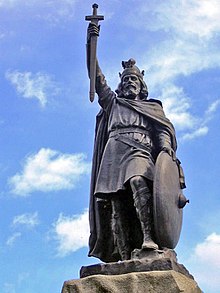Alfred the Great
| Alfred o Wessex | |||||
|---|---|---|---|---|---|
 Statue o Alfred the Great bi Hamo Thornycroft in Winchester, unveiled during the millenary celebrations o Alfred's daith. | |||||
| Keeng o Wessex | |||||
| Ring | 23 Aprile 871 – 26 October 899 | ||||
| Predecessor | Æthelred | ||||
| Successor | Edward | ||||
| Born | 849 The Ryal Palace, Wantage, Oxfordshire | ||||
| Dee'd | 26 October 899 (aroond 50) Winchester | ||||
| Buirial | ca. 1100 Hyde Abbey, Winchester, Hampshire, nou lost | ||||
| Spouse | Ealhswith | ||||
| Issue | Æthelflæd, Lady o the Mercians Edward, Keeng o Wessex Æthelgifu abbess o Shaftesbury Æthelweard o Wessex Ælfthryth, Coontess o Flanders | ||||
| |||||
| Hoose | Hoose o Wessex | ||||
| Hoose | Hoose o Wessex | ||||
| Faither | Æthelwulf, Keeng o Wessex | ||||
| Mither | Osburh | ||||
| Releegion | Roman Catholicism | ||||
Alfred the Great (849 – 26 October 899) (Auld Inglis: [Ælfrēd, Ælfrǣd] error: {{lang}}: text has italic markup (help), "elf coonsel") was King o Wessex frae 871 tae 899. He wis the youngest son o King Æthelwulf o Wessex. His faither dee'd whan he wis young an three o Alfred's brothers, Æthelbald, Æthelberht an Æthelred, ringed in turn.
Efter accedin tae the throne, Alfred spent several years fechtin Viking invasions. He wan a decisive veectory in the Battle o Edington in 878 an made a greement wi the Vikings, creautin what wis kent as Danelaw in the North o Ingland. Alfred an aw owersaw the conversion o Viking leader Guthrum tae Christianity. He defendit his kinrick against the Viking attempt at conquest, acomin the dominant ruler in Ingland.[1] Details o his life are descrived in a wark bi 9t-century Welsh scholar an bishop Asser.
Alfred haed a reputation as a learned an mercifu man o a gracious an level-heidit natur that encouraged eddication, proponin that primar eddication be conductit in Inglis raither nor Laitin an impruivin the legal seestem, militar structur an his fowk's quality o life. He wis gien the epithet "the Great" in an efter the Reformation in the saxteent century. The anerly ither king o Ingland gien this epithet is Cnut the Great.
References
[eedit | eedit soorce]- ↑ Yorke 2001, pp. 27–28.
- Lang an lang-xx template errors
- Alfred the Great
- 849 births
- 899 daiths
- 9t-century Christian saunts
- 9t-century Inglis monarchs
- Anglican saunts
- Chalcedonian Christian monarchs
- Inglis monarchs
- Inglis Roman Catholics
- Inglis saunts
- Medieval legislators
- Patrons o leeteratur
- Fowk frae Wantage
- Roman Catholic ryal saunts
- Wast Saxon monarchs
